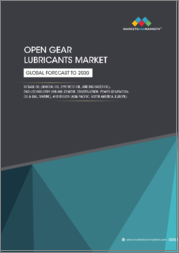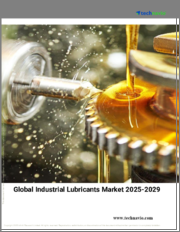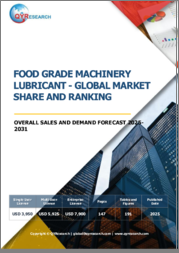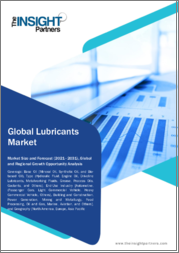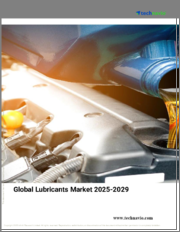
|
시장보고서
상품코드
1618545
세계의 윤활유 시장 : 기유, 제품, 최종 이용 산업, 유통 채널별 예측(2025-2030년)Lubricants Market by Base Oil (Bio-Based Oil, Mineral Oil, Synthetic Oil), Product (Compressor Oil, Engine Oil, Gear Oil), End-Use Industry, Distribution Channel - Global Forecast 2025-2030 |
||||||
윤활유 시장의 2023년 시장 규모는 1,455억 8,000만 달러로 평가되었습니다. 2024년에는 1,517억 1,000만 달러에 달할 것으로 예측되며, CAGR 4.31%로 성장하고, 2030년에는 1,957억 4,000만 달러에 달할 것으로 예상됩니다.
윤활유 시장에는 접촉하는 기계 부품 사이의 마찰, 열, 마모를 줄이기 위해 설계된 폭넓은 제품이 포함됩니다. 산업기계, 해양, 항공, 제조업 등 다양한 산업에서 필수적입니다. 유지 보수 비용을 최소화하는 능력에서 유래합니다. 엔진, 기어, 유압 시스템, 압축기, 터빈 등의 용도로 사용되며, 운송, 에너지, 중공업 등 최종 용도 분야에서 부드러운 운전 및 다운타임 절감 보장하는 데 중요한 역할을합니다.
| 주요 시장 통계 | |
|---|---|
| 기준년(2023) | 1,455억 8,000만 달러 |
| 추정년(2024) | 1,517억 1,000만 달러 |
| 예측년(2030) | 1,957억 4,000만 달러 |
| CAGR(%) | 4.31% |
시장 성장의 주요 원동력은 자동차 섹터의 확대, 신흥국에서의 산업 활동의 활성화, 효율과 환경면의 장점을 향상시키는 윤활유 배합의 기술 진보입니다. 기름으로의 전환도 기업이 엄격합니다. 환경 규제를 충족시키기 위한 지속 가능한 솔루션을 추구하는 중에서 큰 성장 기회를 가져오고 있습니다.
그러나 원유 가격 변동으로 인한 기유 비용 영향, 윤활유 폐기와 관련된 환경 문제, 전기자동차 출현으로 인한 기존 윤활유 수요 감소 등 시장은 몇 가지 과제에 직면하고 있습니다. 이를 극복하기 위해서는 생분해성, 에너지 효율적인 윤활유의 배합과 윤활유의 성능을 모니터링하기 위한 고급 분석 도구에 대한 광범위한 조사 개발이 필요합니다.
이노베이션은 다기능 특성을 가진 윤활유의 개발에 주력함으로써 실현하는 것이 최선이며, 환경에 대한 영향을 억제하면서 기계의 수명과 성능을 향상시킬 수 있습니다. 디지털 기술을 통합하여 실시간 모니터링 및 예보에 완전히 활용하는 것도 중요합니다. 미개척 부문을 획득하고 장기적인 사업 성장을 보장하는 데 유리한 입장에 있습니다.
시장 역학: 빠르게 진화하는 윤활유 시장의 주요 시장 인사이트 공개
윤활유 시장은 수요 및 공급의 역동적인 상호 작용에 의해 변모를 이루고 있습니다. 비즈니스 기회를 획득할 수 있습니다. 이러한 동향을 종합적으로 파악함으로써 기업은 정치적, 지리적, 기술적, 사회적, 경제적 영역에 걸친 다양한 위험을 완화할 수 있으며, 소비자 행동과 그것이 제조 비용과 구매 동향에 미치는 영향을보다 명확하게 이해할 수 있습니다.
- 시장 성장 촉진요인
- 산업 및 자동차 부문의 급성장과 적절한 엔진 오일의 필요성
- 석유 드릴링 프로젝트에 대한 정부의 지원 투자와 정책
- 시장 성장 억제요인
- 윤활유와 관련된 엄격한 규제
- 시장 기회
- 윤활유의 합성·추출 공정의 진보
- 환경 의식의 고조와 지속 가능한 바이오의 윤활유에 대한 수요
- 시장의 과제
- 윤활유의 원재료 가격 변동
Porter's Five Force : 윤활유 시장을 탐색하는 전략 도구
Porter's Five Force Framework는 윤활유 시장 경쟁 구도를 이해하는 중요한 도구입니다. 프레임워크는 기업이 시장 내 세력도를 평가하고 신규 사업의 수익성을 판단하는 데 도움이 됩니다. 더 강인한 시장에서 포지셔닝을 보장 할 수 있습니다.
PESTLE 분석 : 윤활유 시장의 외부 영향을 파악
외부 거시 환경 요인은 윤활유 시장의 성과 역학을 형성하는 데 매우 중요한 역할을합니다. PESTLE 요인을 조사함으로써 기업은 잠재적인 위험과 기회를 더 잘 이해할 수 있습니다. 적극적인 의사 결정을 할 준비가되어 있습니다.
시장 점유율 분석 : 윤활유 시장 경쟁 구도 파악
윤활유 시장의 상세한 시장 점유율 분석을 통해 공급업체의 성과를 종합적으로 평가할 수 있습니다. 이 분석을 통해 시장 집중, 단편화, 통합 동향을 밝혀내고 벤더는 경쟁이 치열해지는 가운데 자신의 지위를 높이는 전략적 의사결정을 하기 위해 필요한 지견을 얻을 수 있습니다.
FPNV 포지셔닝 매트릭스 : 윤활유 시장에서 공급업체의 성능 평가
FPNV 포지셔닝 매트릭스는 윤활유 시장에서 벤더를 평가하는 중요한 도구입니다. 기본 결정을 내릴 수 있습니다. 네 가지 사분면을 통해 벤더를 명확하고 정확하게 분할하고 전략 목표에 가장 적합한 파트너 및 솔루션을 파악할 수 있습니다.
전략 분석 및 권장 : 윤활유 시장에서 성공을 위한 길을 그리기
윤활유 시장의 전략 분석은 세계 시장에서의 프레즌스 강화를 목표로 하는 기업에 필수적인 요소입니다. 이러한 접근 방식을 통해 경쟁 구도에서 과제를 극복하고 새로운 비즈니스 기회를 활용하여 장기적인 성공을 거둘 수 있는 체제를 구축할 수 있습니다.
이 보고서는 주요 관심 분야를 포괄하는 시장의 종합적인 분석을 제공합니다.
1. 시장 침투: 현재 시장 환경의 상세한 검토, 주요 기업의 광범위한 데이터, 시장 도달범위 및 전반적인 영향력 평가.
2. 시장 개척도: 신흥 시장의 성장 기회를 파악하고 기존 분야의 확장 가능성을 평가하며 미래 성장을 위한 전략적 로드맵을 제공합니다.
3. 시장 다양화: 최근 제품 출시, 미개척 지역, 업계의 주요 진보, 시장을 형성하는 전략적 투자를 분석합니다.
4. 경쟁 평가 및 정보 : 경쟁 구도를 철저히 분석하여 시장 점유율, 사업 전략, 제품 포트폴리오, 인증, 규제 당국 승인, 특허 동향, 주요 기업의 기술 진보 등을 검증합니다.
5. 제품 개발 및 혁신 : 미래 시장 성장을 가속할 것으로 예상되는 최첨단 기술, R&D 활동, 제품 혁신을 강조합니다.
또한 이해관계자가 충분한 정보를 얻고 의사결정을 할 수 있도록 중요한 질문에 대답하고 있습니다.
1. 현재 시장 규모와 향후 성장 예측은?
2. 최고의 투자 기회를 제공하는 제품, 부문 및 지역은 어디입니까?
3. 시장을 형성하는 주요 기술 동향과 규제의 영향은?
4. 주요 벤더의 시장 점유율과 경쟁 포지션은?
5. 벤더 시장 진입·철수 전략의 원동력이 되는 수익원과 전략적 기회는 무엇인가?
목차
제1장 서문
제2장 조사 방법
제3장 주요 요약
제4장 시장 개요
제5장 시장 인사이트
- 시장 역학
- 성장 촉진요인
- 산업 및 자동차 부문의 급속한 성장과 적절한 엔진 오일의 필요성
- 석유 드릴링 프로젝트에 대한 정부의 지원 투자와 정책
- 억제요인
- 윤활유와 관련된 엄격한 규제
- 기회
- 윤활유의 합성과 추출 공정의 진보
- 환경 의식의 고조와 지속 가능한 바이오 수요 윤활유
- 과제
- 윤활유의 원재료 가격 변동
- 성장 촉진요인
- 시장 세분화 분석
- 베이스 오일: 생분해성과 저독성 때문에 바이오 베이스 오일이 선호되는 경향이 높아지고 있습니다.
- 최종 이용 산업 : 중장비의 마모를 줄이기 위해 다양한 산업 환경에서 윤활유의 사용을 늘리고 있습니다.
- Porter's Five Forces 분석
- PESTEL 분석
- 정치적
- 경제
- 사교
- 기술적
- 법률상
- 환경
제6장 윤활유 시장 : 베이스 오일별
- 바이오 베이스 오일
- 미네랄 오일
- 합성유
제7장 윤활유 시장 : 제품별
- 컴프레서 오일
- 엔진 오일
- 기어 오일
- 그리스
- 유압작동유
- 금속가공유
- 냉동기유
- 섬유 기계 윤활유
- 변압기유
- 터빈 오일
제8장 윤활유 시장 : 최종 이용 산업별
- 산업
- 자동차 제조
- 시멘트 생산
- 화학약품
- 건설
- 식품가공
- 광업 및 금속
- 석유 및 가스
- 발전
- 섬유
- 교통기관
- 항공
- 상용차
- 해양
- 승용차
- 철도
제9장 윤활유 시장 : 유통 채널별
- 직접 판매
- 리셀러
제10장 아메리카 윤활유 시장
- 아르헨티나
- 브라질
- 캐나다
- 멕시코
- 미국
제11장 아시아태평양의 윤활유 시장
- 호주
- 중국
- 인도
- 인도네시아
- 일본
- 말레이시아
- 필리핀
- 싱가포르
- 한국
- 대만
- 태국
- 베트남
제12장 유럽·중동 및 아프리카의 윤활유 시장
- 덴마크
- 이집트
- 핀란드
- 프랑스
- 독일
- 이스라엘
- 이탈리아
- 네덜란드
- 나이지리아
- 노르웨이
- 폴란드
- 카타르
- 러시아
- 사우디아라비아
- 남아프리카
- 스페인
- 스웨덴
- 스위스
- 터키
- 아랍에미리트(UAE)
- 영국
제13장 경쟁 구도
- 시장 점유율 분석 2023
- FPNV 포지셔닝 매트릭스, 2023
- 경쟁 시나리오 분석
- Savsol 윤활유가 폭넓은 용도를 위한 혁신적인 Ester-5 윤활유를 발표
- ONGC와 IOC는 석유 탐사와 생산 강화에 1.2만 루피를 투자합니다.
- Castrol, 신제품의 발매로 고급 자동차 케어 시장에의 진출을 개시
- 전략 분석과 제안
기업 목록
- AMSOIL Inc.
- Bharat Petroleum Corporation Limited
- BP PLC
- Castrol Limited
- Chevron Corporation
- Enilive SpA
- FUCHS SE
- Gazpromneft oils
- Gulf Oil International Ltd.
- Hindustan Petroleum Corporation
- Idemitsu Kosan Co. Ltd
- Indian Oil Corporation Limited.
- LLK-International
- Lubrizol Corporation
- Motul SA
- Ravensberger Schmierstoffvertrieb GmbH
- Repsol SA
- Shell International BV
- Sinopec Corporation
- Tide Water Oil Co.(India) Ltd.
- TotalEnergies SA
- Valvoline Inc. by Aramco
- Freudenberg SE
The Lubricants Market was valued at USD 145.58 billion in 2023, expected to reach USD 151.71 billion in 2024, and is projected to grow at a CAGR of 4.31%, to USD 195.74 billion by 2030.
The lubricants market encompasses a wide range of products designed to reduce friction, heat, and wear between mechanical parts in contact. Typically composed of base oils and additives, lubricants are vital across various industries, including automotive, industrial machinery, marine, aviation, and manufacturing. Their necessity stems from their ability to enhance operational efficiency, extend equipment life, and minimize maintenance costs. They find applications in engines, gears, hydraulic systems, compressors, and turbines, making them crucial for ensuring smooth operation and reduced downtime in end-use sectors such as transportation, energy, and heavy industries.
| KEY MARKET STATISTICS | |
|---|---|
| Base Year [2023] | USD 145.58 billion |
| Estimated Year [2024] | USD 151.71 billion |
| Forecast Year [2030] | USD 195.74 billion |
| CAGR (%) | 4.31% |
Market growth is predominantly driven by the expanding automotive sector, rising industrial activities in emerging economies, and technological advancements in lubricant formulations that offer improved efficiency and environmental benefits. The shift towards high-performance synthetic lubricants and bio-based alternatives also presents significant growth opportunities as companies seek sustainable solutions to meet stringent environmental regulations. Additionally, the increasing focus on energy efficiency and innovation in additive technologies is expected to create potential paths for market expansion.
However, the market faces several challenges, including volatile crude oil prices impacting base oil costs, environmental concerns regarding lubricant disposal, and the emergence of electric vehicles reducing conventional lubricant demand. To overcome these limitations, extensive research and development are required in biodegradable and energy-efficient lubricant formulations, as well as advanced analytical tools for monitoring lubricant performance.
Innovation can be best realized by focusing on the development of lubricants with multifunctional properties, enhancing the lifespan and performance of machinery while reducing environmental impact. Another area for advancement is the integration of digital technologies such as IoT and AI for real-time monitoring and predictive maintenance. With the market being dynamic and evolving, companies that proactively adopt sustainable practices and leverage technological innovations are well-positioned to gain competitive advantages and capture untapped segments in the lubrication industry, ensuring long-term business growth.
Market Dynamics: Unveiling Key Market Insights in the Rapidly Evolving Lubricants Market
The Lubricants Market is undergoing transformative changes driven by a dynamic interplay of supply and demand factors. Understanding these evolving market dynamics prepares business organizations to make informed investment decisions, refine strategic decisions, and seize new opportunities. By gaining a comprehensive view of these trends, business organizations can mitigate various risks across political, geographic, technical, social, and economic domains while also gaining a clearer understanding of consumer behavior and its impact on manufacturing costs and purchasing trends.
- Market Drivers
- Exponential growth of the industrial and automotive sectors and the need for suitable engine oil
- Supportive government investments and policies for oil drilling projects
- Market Restraints
- Strict regulations associated with the lubricants
- Market Opportunities
- Advancements in the synthesis and extraction process of lubricants
- Increasing environmental awareness and the demand for sustainable, bio-based lubricants
- Market Challenges
- Fluctuations in the prices of raw materials for lubricants
Porter's Five Forces: A Strategic Tool for Navigating the Lubricants Market
Porter's five forces framework is a critical tool for understanding the competitive landscape of the Lubricants Market. It offers business organizations with a clear methodology for evaluating their competitive positioning and exploring strategic opportunities. This framework helps businesses assess the power dynamics within the market and determine the profitability of new ventures. With these insights, business organizations can leverage their strengths, address weaknesses, and avoid potential challenges, ensuring a more resilient market positioning.
PESTLE Analysis: Navigating External Influences in the Lubricants Market
External macro-environmental factors play a pivotal role in shaping the performance dynamics of the Lubricants Market. Political, Economic, Social, Technological, Legal, and Environmental factors analysis provides the necessary information to navigate these influences. By examining PESTLE factors, businesses can better understand potential risks and opportunities. This analysis enables business organizations to anticipate changes in regulations, consumer preferences, and economic trends, ensuring they are prepared to make proactive, forward-thinking decisions.
Market Share Analysis: Understanding the Competitive Landscape in the Lubricants Market
A detailed market share analysis in the Lubricants Market provides a comprehensive assessment of vendors' performance. Companies can identify their competitive positioning by comparing key metrics, including revenue, customer base, and growth rates. This analysis highlights market concentration, fragmentation, and trends in consolidation, offering vendors the insights required to make strategic decisions that enhance their position in an increasingly competitive landscape.
FPNV Positioning Matrix: Evaluating Vendors' Performance in the Lubricants Market
The Forefront, Pathfinder, Niche, Vital (FPNV) Positioning Matrix is a critical tool for evaluating vendors within the Lubricants Market. This matrix enables business organizations to make well-informed decisions that align with their goals by assessing vendors based on their business strategy and product satisfaction. The four quadrants provide a clear and precise segmentation of vendors, helping users identify the right partners and solutions that best fit their strategic objectives.
Strategy Analysis & Recommendation: Charting a Path to Success in the Lubricants Market
A strategic analysis of the Lubricants Market is essential for businesses looking to strengthen their global market presence. By reviewing key resources, capabilities, and performance indicators, business organizations can identify growth opportunities and work toward improvement. This approach helps businesses navigate challenges in the competitive landscape and ensures they are well-positioned to capitalize on newer opportunities and drive long-term success.
Key Company Profiles
The report delves into recent significant developments in the Lubricants Market, highlighting leading vendors and their innovative profiles. These include AMSOIL Inc., Bharat Petroleum Corporation Limited, BP PLC, Castrol Limited, Chevron Corporation, Enilive S.p.A., FUCHS SE, Gazpromneft oils, Gulf Oil International Ltd., Hindustan Petroleum Corporation, Idemitsu Kosan Co. Ltd, Indian Oil Corporation Limited., LLK-International, Lubrizol Corporation, Motul S.A., Ravensberger Schmierstoffvertrieb GmbH, Repsol S.A., Shell International B.V., Sinopec Corporation, Tide Water Oil Co. (India) Ltd., TotalEnergies SA, Valvoline Inc. by Aramco, and Freudenberg SE.
Market Segmentation & Coverage
This research report categorizes the Lubricants Market to forecast the revenues and analyze trends in each of the following sub-markets:
- Based on Base Oil, market is studied across Bio-Based Oil, Mineral Oil, and Synthetic Oil.
- Based on Product, market is studied across Compressor Oil, Engine Oil, Gear Oil, Grease, Hydraulic Fluid, Metalworking fluid, Refrigeration Oil, Textile Machinery Lubricants, Transformer Oil, and Turbine Oil.
- Based on End-Use Industry, market is studied across Industrial and Transportation. The Industrial is further studied across Automobile Manufacturing, Cement Production, Chemical, Construction, Food Processing, Mining & Metal, Oil & Gas, Power Generation, and Textile. The Transportation is further studied across Aviation, Commercial Vehicles, Marine, Passenger Vehicles, and Railways.
- Based on Distribution Channel, market is studied across Direct Sale and Distributors/Dealers.
- Based on Region, market is studied across Americas, Asia-Pacific, and Europe, Middle East & Africa. The Americas is further studied across Argentina, Brazil, Canada, Mexico, and United States. The United States is further studied across California, Florida, Illinois, New York, Ohio, Pennsylvania, and Texas. The Asia-Pacific is further studied across Australia, China, India, Indonesia, Japan, Malaysia, Philippines, Singapore, South Korea, Taiwan, Thailand, and Vietnam. The Europe, Middle East & Africa is further studied across Denmark, Egypt, Finland, France, Germany, Israel, Italy, Netherlands, Nigeria, Norway, Poland, Qatar, Russia, Saudi Arabia, South Africa, Spain, Sweden, Switzerland, Turkey, United Arab Emirates, and United Kingdom.
The report offers a comprehensive analysis of the market, covering key focus areas:
1. Market Penetration: A detailed review of the current market environment, including extensive data from top industry players, evaluating their market reach and overall influence.
2. Market Development: Identifies growth opportunities in emerging markets and assesses expansion potential in established sectors, providing a strategic roadmap for future growth.
3. Market Diversification: Analyzes recent product launches, untapped geographic regions, major industry advancements, and strategic investments reshaping the market.
4. Competitive Assessment & Intelligence: Provides a thorough analysis of the competitive landscape, examining market share, business strategies, product portfolios, certifications, regulatory approvals, patent trends, and technological advancements of key players.
5. Product Development & Innovation: Highlights cutting-edge technologies, R&D activities, and product innovations expected to drive future market growth.
The report also answers critical questions to aid stakeholders in making informed decisions:
1. What is the current market size, and what is the forecasted growth?
2. Which products, segments, and regions offer the best investment opportunities?
3. What are the key technology trends and regulatory influences shaping the market?
4. How do leading vendors rank in terms of market share and competitive positioning?
5. What revenue sources and strategic opportunities drive vendors' market entry or exit strategies?
Table of Contents
1. Preface
- 1.1. Objectives of the Study
- 1.2. Market Segmentation & Coverage
- 1.3. Years Considered for the Study
- 1.4. Currency & Pricing
- 1.5. Language
- 1.6. Stakeholders
2. Research Methodology
- 2.1. Define: Research Objective
- 2.2. Determine: Research Design
- 2.3. Prepare: Research Instrument
- 2.4. Collect: Data Source
- 2.5. Analyze: Data Interpretation
- 2.6. Formulate: Data Verification
- 2.7. Publish: Research Report
- 2.8. Repeat: Report Update
3. Executive Summary
4. Market Overview
5. Market Insights
- 5.1. Market Dynamics
- 5.1.1. Drivers
- 5.1.1.1. Exponential growth of the industrial and automotive sectors and the need for suitable engine oil
- 5.1.1.2. Supportive government investments and policies for oil drilling projects
- 5.1.2. Restraints
- 5.1.2.1. Strict regulations associated with the lubricants
- 5.1.3. Opportunities
- 5.1.3.1. Advancements in the synthesis and extraction process of lubricants
- 5.1.3.2. Increasing environmental awareness and the demand for sustainable, bio-based lubricants
- 5.1.4. Challenges
- 5.1.4.1. Fluctuations in the prices of raw materials for lubricants
- 5.1.1. Drivers
- 5.2. Market Segmentation Analysis
- 5.2.1. Base Oil: Growing preference for bio-based oils due to their biodegradability and lower toxicity
- 5.2.2. End-Use Industry: Increasing usage of lubricants in varied industrial settings to reduce wear and tear on heavy machinery
- 5.3. Porter's Five Forces Analysis
- 5.3.1. Threat of New Entrants
- 5.3.2. Threat of Substitutes
- 5.3.3. Bargaining Power of Customers
- 5.3.4. Bargaining Power of Suppliers
- 5.3.5. Industry Rivalry
- 5.4. PESTLE Analysis
- 5.4.1. Political
- 5.4.2. Economic
- 5.4.3. Social
- 5.4.4. Technological
- 5.4.5. Legal
- 5.4.6. Environmental
6. Lubricants Market, by Base Oil
- 6.1. Introduction
- 6.2. Bio-Based Oil
- 6.3. Mineral Oil
- 6.4. Synthetic Oil
7. Lubricants Market, by Product
- 7.1. Introduction
- 7.2. Compressor Oil
- 7.3. Engine Oil
- 7.4. Gear Oil
- 7.5. Grease
- 7.6. Hydraulic Fluid
- 7.7. Metalworking fluid
- 7.8. Refrigeration Oil
- 7.9. Textile Machinery Lubricants
- 7.10. Transformer Oil
- 7.11. Turbine Oil
8. Lubricants Market, by End-Use Industry
- 8.1. Introduction
- 8.2. Industrial
- 8.2.1. Automobile Manufacturing
- 8.2.2. Cement Production
- 8.2.3. Chemical
- 8.2.4. Construction
- 8.2.5. Food Processing
- 8.2.6. Mining & Metal
- 8.2.7. Oil & Gas
- 8.2.8. Power Generation
- 8.2.9. Textile
- 8.3. Transportation
- 8.3.1. Aviation
- 8.3.2. Commercial Vehicles
- 8.3.3. Marine
- 8.3.4. Passenger Vehicles
- 8.3.5. Railways
9. Lubricants Market, by Distribution Channel
- 9.1. Introduction
- 9.2. Direct Sale
- 9.3. Distributors/Dealers
10. Americas Lubricants Market
- 10.1. Introduction
- 10.2. Argentina
- 10.3. Brazil
- 10.4. Canada
- 10.5. Mexico
- 10.6. United States
11. Asia-Pacific Lubricants Market
- 11.1. Introduction
- 11.2. Australia
- 11.3. China
- 11.4. India
- 11.5. Indonesia
- 11.6. Japan
- 11.7. Malaysia
- 11.8. Philippines
- 11.9. Singapore
- 11.10. South Korea
- 11.11. Taiwan
- 11.12. Thailand
- 11.13. Vietnam
12. Europe, Middle East & Africa Lubricants Market
- 12.1. Introduction
- 12.2. Denmark
- 12.3. Egypt
- 12.4. Finland
- 12.5. France
- 12.6. Germany
- 12.7. Israel
- 12.8. Italy
- 12.9. Netherlands
- 12.10. Nigeria
- 12.11. Norway
- 12.12. Poland
- 12.13. Qatar
- 12.14. Russia
- 12.15. Saudi Arabia
- 12.16. South Africa
- 12.17. Spain
- 12.18. Sweden
- 12.19. Switzerland
- 12.20. Turkey
- 12.21. United Arab Emirates
- 12.22. United Kingdom
13. Competitive Landscape
- 13.1. Market Share Analysis, 2023
- 13.2. FPNV Positioning Matrix, 2023
- 13.3. Competitive Scenario Analysis
- 13.3.1. Savsol Lubricants Introduces Innovative Ester-5 Lubricants for Widespread Use
- 13.3.2. ONGC and IOC to Invest INR 1.2 Lakh Crore in Enhancing Oil Exploration and Production by 2025
- 13.3.3. Castrol Initiates Expansion into Premium Auto Care Market with New Product Launch
- 13.4. Strategy Analysis & Recommendation
Companies Mentioned
- 1. AMSOIL Inc.
- 2. Bharat Petroleum Corporation Limited
- 3. BP PLC
- 4. Castrol Limited
- 5. Chevron Corporation
- 6. Enilive S.p.A.
- 7. FUCHS SE
- 8. Gazpromneft oils
- 9. Gulf Oil International Ltd.
- 10. Hindustan Petroleum Corporation
- 11. Idemitsu Kosan Co. Ltd
- 12. Indian Oil Corporation Limited.
- 13. LLK-International
- 14. Lubrizol Corporation
- 15. Motul S.A.
- 16. Ravensberger Schmierstoffvertrieb GmbH
- 17. Repsol S.A.
- 18. Shell International B.V.
- 19. Sinopec Corporation
- 20. Tide Water Oil Co. (India) Ltd.
- 21. TotalEnergies SA
- 22. Valvoline Inc. by Aramco
- 23. Freudenberg SE






